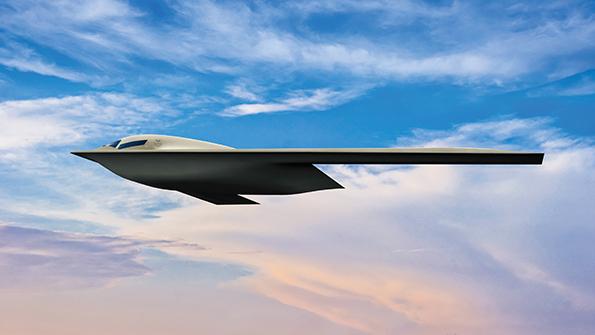
A windshield rendering is not often a window into the design philosophy behind a new aircraft, but that is not the case in the ultrasecretive world of the Northrop Grumman B-21 program.
In fact, the oddly upward-sloping side cockpit window revealed in the latest of three official B-21 renderings is the first visual design change from the B-2 configuration that program officials have been allowed to explain.
- Northrop explains reason for new windshield layout
- Lab and flying testbed helping to mature mission systems
Building on more than three decades of B-2 operations, Northrop knew the similarly configured B-21 needed a new windscreen layout in the cockpit. Although the B-2’s four-pane layout offered excellent forward visibility, B-21 pilots need better lateral visibility, especially higher on the sides of the cockpit during refueling operations.
“You’ve got to be able to have a broad field of view for flight operations, not just a forward view,” Chris Daughters, vice president of engineering for Northrop’s aeronautics business, tells Aviation Week in the first interview about the bomber by a company official.
The renderings of the B-21 show other visual changes from a similar flying-wing layout of the B-2 that possibly reveal advances in stealth design (relocated engine inlets), a lighter aircraft (smaller landing gear) and a shift to high-altitude operations (a V-shaped trailing edge).
But Northrop executives and U.S. Air Force and Rapid Capabilities Office officials have been hinting at deeper changes in the underlying design philosophy of the B-21 compared with the B-2. The goal is to avoid a “curse” that has struck the Air Force’s three previous attempts to field a stealthy combat aircraft, which caused costly development cycles that spanned two decades for the B-2 and the Lockheed Martin F-22 and F-35.
The B-2 proved to be an operational success but a programmatic disappointment, with only 21 aircraft acquired instead of the 132 planned. Thirty years after the B-2’s first flight, the Air Force’s “preferred” future bomber fleet now comprises 225 aircraft. Following the scheduled retirements of the B-2 and Rockwell B-1B fleets by the end of the 2030s, the future Air Force fleet would include 150 B-21s and 75 Boeing B-52s—if Northrop can deliver the new bomber with the projected average cost of about $511 million each in 2012 dollars.
If the B-21 is to avoid the “curse,” the design philosophy behind the windshield layout hints at Northrop’s new approach. The B-21 has a clean-sheet design, but that does not mean Northrop’s engineers started with a blank sheet of paper. As the second generation of a flying-wing bomber designed by the same company, the B-21 affords the rare opportunity for an aerospace industry do-over. The similarity of the two bombers’ aerodynamic layouts is itself an advantage.
“Whereas [the] B-2 required frequent invention to achieve performance within the constraints imposed by physics, the same commitment of resources can now be devoted to designing for performance, sustainment and affordability,” Daughters says.
This enables Northrop to concentrate on maturing the B-21’s mission systems. The contrast to previous programs is striking: The F-22 program flew for three years before Lockheed integrated the aircraft’s radar; the F-35 radar was not ready until four years after flight tests began. The B-21 program’s goal is to begin flight testing with the mission systems already integrated. The company has operated a flying testbed with the B-21 mission systems for at least two years and has opened a 270,000-ft.2 laboratory.
“In my 35 years in the industry, I have never seen a better-equipped lab facility than we have in Melbourne, [Florida],” Daughters says.
Those up-front investments put the B-21 program in a different place nearly six years after Northrop won the Long-Range Strike Bomber contract on Oct. 27, 2015. The F-22 and F-35 entered flight testing 1-2 years earlier than scheduled for the B-21 after contract award, but the B-21 program’s ultimate goal is to achieve initial operational capability (IOC) several years faster than any previous stealth aircraft.
A rollout ceremony for the first of five B-21 test aircraft is scheduled in early 2022 at Northrop’s manufacturing site in Palmdale, California, and first flight is expected to follow by the end of next year.
To break the “curse,” the test for Northrop will be when the B-21 achieves IOC. If it can beat the F-22’s and F-35A’s 14-year interval between contract award and IOC and the B-2’s 16-year cycle, the B-21 should have a much better chance of meeting the Air Force’s inventory target.






Comments
Clearly the B-52 is a hell of an airplane - hopefully they'll hang some new engines on it soon.